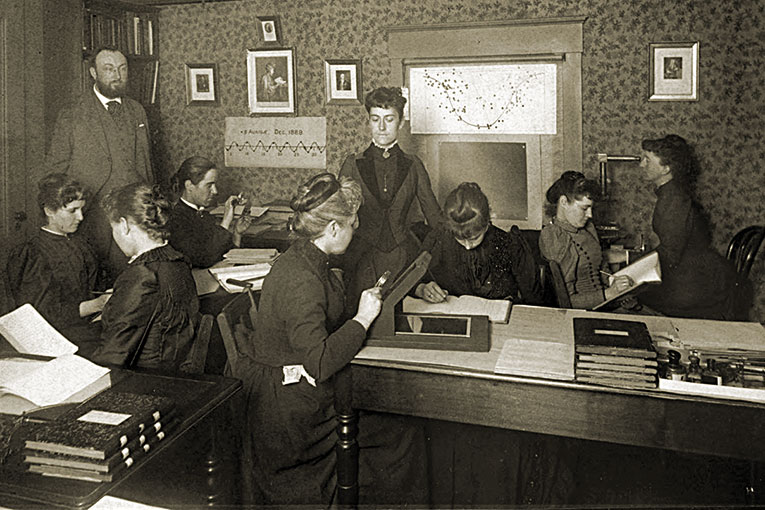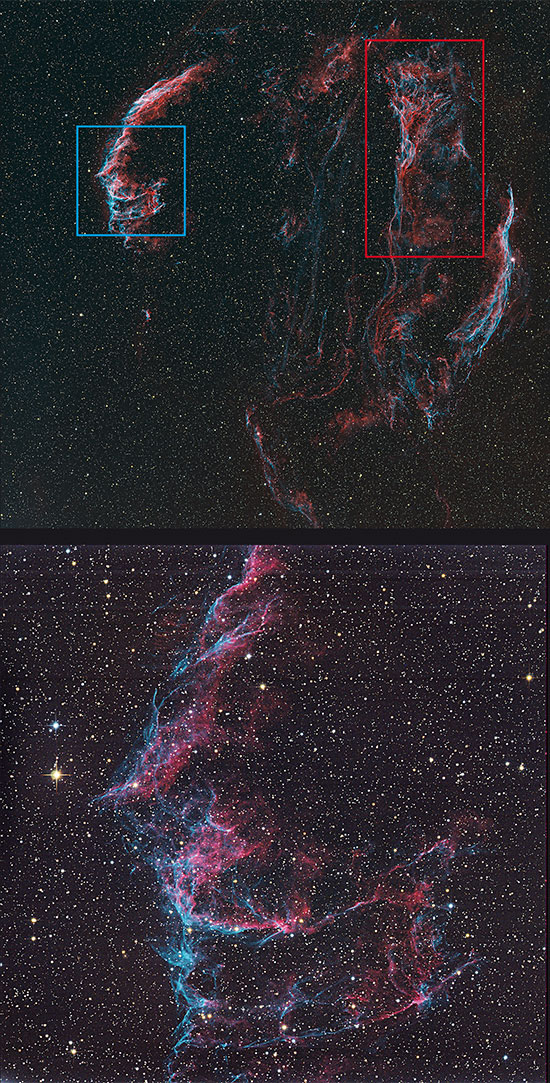
 Cortesia de Harvard College Observatory Cortesia de Harvard College ObservatoryHarvard’s «computers» in 1891. Williamina Fleming is standing in the centre of the image and Edward Pickering is on the left. Nowadays the star classification system initiated by Fleming is still in use. |
||
|
It looks like a cosmic conspiracy. Since the telescope was invented, no explosion of a supernova in our galaxy has been visible from Earth. There have been other in nearby galaxies and of course in many distant galaxies, but the last supernova that exploded in the Milky Way was observed more than 400 years ago. Those were the times of Johannes Kepler (1571-1630) and Galileo Galilei (1564-1642). They and their peers were able to enjoy a spectacle that has not repeated: seeing at a glance a new star in our galaxy. A few years before, in 1572, the Valencian astronomer Jerónimo Muñoz (1520-1591) observed another. Important astronomers of the time, as the Dane Tycho Brahe (1546-1601), studied it in detail. According to Víctor Navarro, professor of History of Science of the University of Valencia, Muñoz was informed by some shepherds and limekiln workers from Torrent. These, used to working at night and observing the sky and identifying, with experienced eyes, the W pattern that forms the constellation of Cassiopeia, were surprised to see a celestial intruder in that well-known region of the sky. Convinced that the star had not been there before, they alerted Jerónimo Muñoz, professor of Hebrew, mathematics, and astronomy of the Studium generale, of its presence. The commotion was such that King Philip II commissioned Muñoz a study on the new star. Munoz conducted systematic observations and wrote, in a few months, a treatise entitled: Book on the new comet. Brahe, on the other hand, considered it a new star, but praised the remarks of Muñoz. When a star explodes as a supernova in our galaxy, you can see it even in daylight and it dominates the night sky for a few weeks or months. The stars are stable because there is a balance between the gravitational tendency to make the star collapse and the thermal and radiation pressure caused by the process of nuclear fusion that takes place in its interior and that tends to expel the shells out. While there is nuclear fuel to feed these reactions the balance endures, but there comes a time when it is exhausted. The fusion reactions that keep the star stable produce increasingly heavier chemical elements, hydrogen becomes helium and later other elements such as carbon, nitrogen, oxygen, silicon and iron. Beyond iron the fusion consumes energy instead of liberating it and therefore the thermonuclear reactions that maintain the star cease. It falls into crisis and collapses. The rebound of the outer layers with the inner core produces a shock wave that spreads out and projects into the interstellar space the shells of the star with the supernova shape. Part of this ejected material can be observed even thousands of years after the explosion as diffuse remains. |
||
|
|
||
|
One of the remnants of supernovae observed in the sky is located in the constellation of the Swan. It is the Veil Nebula, which we reproduce in these pages. The explosion of the star that caused it took place between the year 6000 and 3000 BC, so the ancient Neolithic civilisations were able to observe it. It would shine like the moon in the crescent phase. The shock wave moved initially at hundreds of thousands of kilometres per hour, perforating and heating the gas surrounding it at millions of degrees. The interstellar medium gradually slowed the expansion, forming nebulosities with twisted forms that remind us of wispy cirrus clouds in the sky or the smoke from a bonfire when mixing with the air. Diminutive filaments that still shine when the gas that constitutes them cools down and whose emission reveals the presence of oxygen, sulphur, and hydrogen. The Nebula is located 1,500 light years from the Earth and covers an area of the sky of three degrees in diameter, that is, approximately six times the diameter of the full moon. The Nebula was discovered in 1784 by the German astronomer based in England William Herschel (1738-1822), discoverer also of the Uranus planet along with his sister Caroline (1750-1848). One of the regions that form the Veil Nebula is called Pickering’s triangle, but it was not Edward Charles Pickering (1846-1919), director of the Harvard College Observatory, who discovered it. It was Williamina Fleming (1857-1911), who worked for him at the Observatory. Williamina, of Scottish origin, had emigrated to Boston with her husband, who abandoned her when she was pregnant. She went to work as a maid in Pickering’s house, who finally hired her in the Observatory along with other women. This group of women – Harvard’s computers – did an outstanding job analysing thousands of photographic plates and plenty of stellar spectra. The star classification system initiated by Fleming and completed by other women in the group, such as Antonia Maury (1866-1952) and Annie Jump Cannon (1863-1941), is still in use today: it divides the stars into seven spectral classes according to their colour (which is related to their surface temperature) and their chemical composition. Fleming also discovered a dark nebula, the Horsehead Nebula, in a photograph that Edward Pickering’s brother, William Henry (1858-1938), had taken. The work of another woman in the group, Henrietta Swan Leavitt (1868-1921), in establishing the relation between the period and the luminosity of Cepheid variable stars was decisive in understanding the distances in astrophysics and cosmology. This study was published in March 1912 and signed exclusively by Edward Pickering, as was the time’s custom. Fortunately the first sentence of the article makes its authorship clear: «The following statement… has been prepared by Miss Leavitt». Edwin Hubble (1889-1953), who used Leavitt’s method to determine the distances to other galaxies, acknowledged that the astronomer was worthy of the Nobel Prize, for which she was curiously nominated in 1924 by Gösta Mittag-Leffler (1846-1927) of the Swedish Academy of Sciences, who did not know that the American astronomer had passed away three years earlier. Mittag-Leffler, whose role had been fundamental for mathematician Sofia Kovalévskaya (1850-1891) to obtain a Chair at the University of Stockholm (the first woman ever to reach this rank), sent the proposal to Pickering’s successor in the address of the Observatory, Harlow Shapley (1885-1972), who, besides informing the Swedish scientist of Leavitt’s death had the not so noble audacity to suggest that he should be the winner of the prize for the interpretation of Leavitt’s results. When removing the veils that cover the works or discoveries of some astronomers, many times their true authors, brilliant women astronomers who in most cases did not receive the deserved recognition in life, come into the spotlight. Vicent J. Martínez. Director of the Astronomical Observatory of the University of Valencia. |
||






